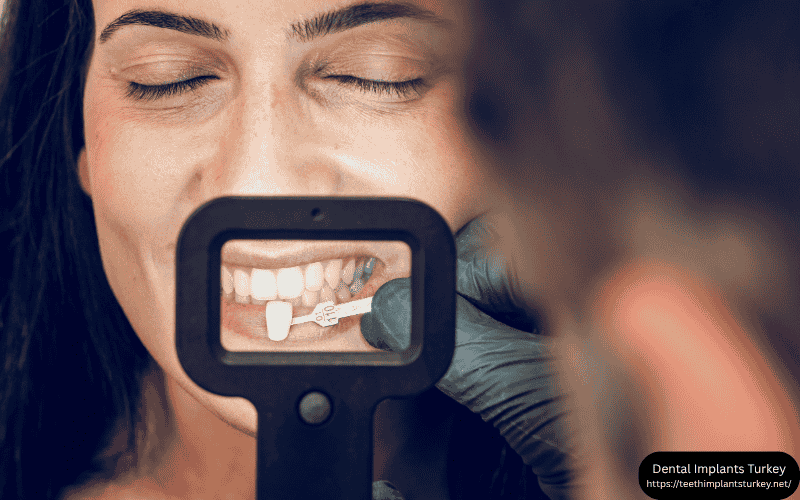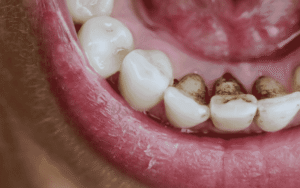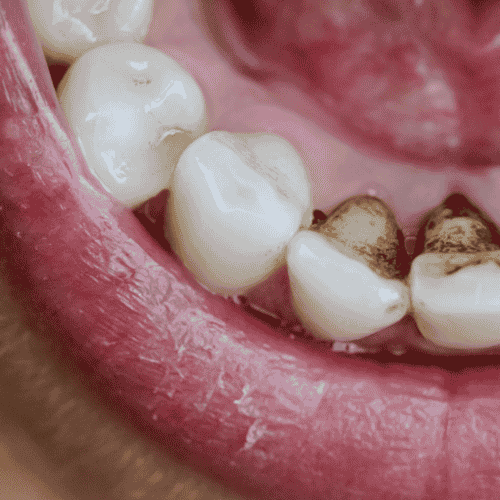Teeth Bonding vs Veneers: A Complete Guide
Teeth bonding and veneers are common ways to get a beautiful smile. Both methods may make your teeth look better, but they work in different ways, take longer, and have different results.
Bonding teeth refers to applying a tooth-colored resin on your teeth and shaping and polishing it to fit your smile. This less invasive treatment can fix small chips, gaps, and discolouration. On the other hand, veneers are thin porcelain or composite shells that cover the front of your teeth to fix big cosmetic problems like misalignment, very yellow teeth, or big gaps.
We will look at these two treatments side by side to help you decide which one is best for your teeth and aesthetic needs. Read on to learn about each option’s pros and downsides, especially the difference between composite bonding and veneers or you can say the difference between composite bonding and composite veneers.
Understanding Cosmetic Dentistry and Smile Enhancement
When you get cosmetic dentistry, your teeth, gums, and smile will look better. The first kind of dentistry fixes teeth and keeps them healthy. The second kind, cosmetic dentistry, improves the way your smile looks. To give you the smile you’ve always wanted, a cosmetic dentist may whiten your teeth, make your gums look better, and fill in tiny gaps.
Composite veneers vs bonding and composite veneers vs composite bonding outperform professional whitening and over-the-counter procedures. These operations permanently brighten, whiten, and perfect your teeth and enhance your appearance.
What Is Teeth Bonding and How Does It Work?
Teeth bonding is an effective, less invasive cosmetic dentistry surgical treatment for many aesthetic issues. Bonding uses a tooth-colored composite resin to fix chips, cracks, gaps, and tooth form or colour. The procedure is simple and usually takes one visit.
To guarantee resin adhesion, your dentist will softly roughen the tooth and apply a conditioning solvent. A unique curing light hardens the resin after sculpting it to fix the fault. Polishing the teeth gives it a natural look.
Bonding is a fast, cheap, and efficient technique to improve a smile. The procedure is durable, although it may not last as long as veneers. Bonding may also stain, particularly if exposed to coffee, tea, or smoke. Dental bonding is great for little flaws, but it may need to be touched up or updated every few years.
What Are Dental Veneers and When Are They Used?
Dental veneers are thin shells that are made just for you and fit over the front of your teeth to make them look normal. Veneers, which can be made of porcelain or composite resin, can make teeth that are severely discoloured, have enamel loss, or have structural problems like cracks or chips look better. They fix problems with misaligned teeth.
Some enamel is taken off the front of your teeth to make room for the veneers. The veneers are then glued on top of your normal teeth. The doctor scans your teeth, which are then sent to a dental lab to be made into veneers that are the exact shape, size, and colour of your teeth. When they are ready, a special glue sticks the veneers to your teeth.
For long-term problems with how your teeth look, veneers are great. People who want a white smile like them because they last a long time and don’t stain. The process takes away the enamel, which can’t be put back on. Dental veneers make teeth look better by giving them a natural, bright look.
Patients often compare composite bonding or veneers, veneers or composite bonding, and composite bonding vs porcelain veneers to determine which suits them best.
Key Differences Between Teeth Bonding and Veneers
When thinking about cosmetic dental operations, it’s important to understand the distinctions between teeth bonding and veneers. Each has different advantages and uses.
1. Materials:
- Teeth bonding involves moulding a flexible, tooth-colored composite resin directly onto the tooth.
- Veneers, made from porcelain or composite resin, provide a lasting and natural finish to the front surface of teeth.
2. Application Techniques:
- Teeth bonding involves applying resin to the tooth, shaping, and hardening with a specific light in one visit.
- To make veneers, enamel removal and specific impressions are needed, followed by a lab visit. It usually takes two or more visits.
3. Durability and Strength:
- Teeth Bonding is durable yet prone to chipping or discolouration after 5-7 years.
- Porcelain veneers withstand stains and last 15+ years, making them a long-term option.
4. Cost:
- Bonding your teeth is a cheap way to make small changes; it usually costs $300 to $600 per tooth.
- Veneers, which cost $1,000 to $3,000 per tooth, make teeth look better and last longer. The cost dental bonding vs veneers comparison shows bonding is cheaper for short-term results, while veneers last longer.
5. Aesthetic Outcomes:
- Teeth bonding is great for small defects since it blends perfectly with existing teeth.
- Veneers provide a consistent and visually better look, excellent for a comprehensive smile makeover.
6. Suitability for Dental Issues:
- Teeth Bonding is ideal for minor chips, gaps, discolouration, or length inconsistencies.
- Veneers are for substantial cosmetic modifications such misalignment, extensive staining, or uneven forms.
Dental bonding is great for quick and cheap cosmetic fixes, while veneers are better for long-lasting, more serious changes that make the smile look better and last longer. Whether you want veneers or bonding, the best choice depends on your tooth problem and the result you want.
Advantages of Choosing Teeth Bonding
Teeth bonding is a flexible and affordable cosmetic surgery that improves smiles. Dental bonding has several benefits:
Cost-Effectiveness
Dental bonding is cheaper than veneers or crowns. It’s ideal for inexpensive cosmetic changes. Dental bonding may fix small chips and gaps without disturbing the budget.
Speed of Procedure
Tooth bonding’s quick speed is it primary positive point. Its one appointment is of 30–60 minutes per tooth for surgery. Bonding is perfect for those who seek results quickly and few sessions or healing procedures. Within hours after leaving the dentist, your smile may improve.
Minimal Enamel Removal
Dental bonding requires less enamel removal, unlike other cosmetic treatments. The dentist simply has to mildly roughen the tooth to assure composite resin bonding. This makes bonding less intrusive, maintaining tooth structure and minimising pain and sensitivity.
Flexibility in Use
Dental bonding is flexible and can cure multiple cosmetic problems. For example, It can restore broken teeth, fix gaps, align uneven teeth, and cosmetically enhance discoloured teeth. You can use dental bonding for specific dental issues.
Repair and Maintenance
Another advantage of dental bonding is durability. Bonding can last for a while, but porcelain veneers last longer. You can fix or re-bond broken or old bonding material, which will cost you less money.
Natural Appearance
Dental bonding looks natural and mixes with your teeth. Bonding composite resin may match your tooth colour for a natural look. A natural, bright smile is achieved without intrusive procedures.
Benefits of Dental Veneers for a Flawless Smile

- Long-term enhancement in the colour, shape, and size of teeth.
- Makes your smile look real and attractive.
- Custom veneers are made to match the colour and shape of your teeth, giving you a one-of-a-kind look.
- A low-maintenance way to get a bright, white smile that lasts and doesn’t get dirty.
- Keeps the natural shape of the teeth with little loss of enamel.
- It fixes teeth that are broken, chipped, or discoloured, as well as those that are out of alignment.
- A quick and easy way to change the way your smile looks.
- Veneers are a flexible and long-lasting way to change how your teeth look.
- Giving someone a beautiful, normal smile could make them feel a lot better about themselves.
Which Option Is Better for Your Smile: Bonding or Veneers?
Dental bonding or veneers should be chosen based on your wants. Bonding your teeth together is a quick and cheap way to fix chips, gaps, and cracks. It can be done in just one visit, but it might need to be touched up and doesn’t last as long as veneers.
Veneers cover the whole front surface of the tooth, which makes them a more durable and long-lasting option for teeth that are badly stained, crooked, or misshapen. Taking off a small amount of enamel takes longer and needs more than one visit. Veneers don’t stain or wear down easily.
The fix is quick and easy. Veneers might be the best way to get a perfect smile that lasts. Teeth Implants Turkey can help you decide on a way to improve your smile.
Suitability: Who Should Consider Teeth Bonding vs Veneers?
Cosmetic Imperfections
Dental bonding is the best way to fix cosmetic problems like chips, cracks, and gaps. It’s cheap and great for small changes. Veneers give a more perfect look to many flaws for big cosmetic changes.
Minor Tooth Damage
At a low cost, dental bonding can fix the look and function of small tooth damage. Veneers are better for bigger cosmetic changes and last longer.
Severe Tooth Discoloration
Veneers work well to fix teeth that are very discoloured. Their finish looks natural and is resistant to stains, so it can get rid of tough stains. Dental bonding can make teeth that are discoloured look better, but it may need to be touched up over time, which makes it less durable than veneers.
Structural Tooth Issues
Veneers can last a long time for structural problems with teeth, like erosion or wear. They make teeth stronger and last longer. Dental bonding is good for small structural problems, but it doesn’t last as long and is better for less serious damage.
Alignment and Spacing Problems
Veneers fix small gaps and misalignments. They fix these problems for good without braces. Dental bonding can fix small gaps and misalignments, but it is most often used for small changes.look to many flaws for big cosmetic changes.
Maintenance and Aftercare for Veneers and Bonding
Taking care of your teeth properly will make dental veneers and bonding last longer. Using a soft-bristled toothbrush and non-abrasive toothpaste twice a day and flossing every day will keep your mouth clean and healthy. An antimicrobial mouthwash may also help get rid of plaque and make teeth look better. To keep your teeth healthy, your dentist should clean and check them often.
Limiting coffee, tea, red wine, and tobacco use can prevent stains and damage. Avoid biting hard objects, which can chip. Dental bonding and veneers may need touch-ups or replacement even with proper care. Regular dental visits allow your dentist to detect and treat issues early. You may enjoy your veneers and bonding for years by following these care guidelines and getting frequent dental checkups.
Common Questions About Teeth Bonding vs Veneers
A lot of people are worried about dental bonding and veneers, their pros and cons, and which one is best for them. These are some common questions that can help you make a decision.
How Much Do You Want to Change the Appearance of Your Teeth?
Dental bonding is a good way to fix small chips, gaps, and changes in the shape of teeth. Veneers can change the shape, size, and colour of your teeth in a bigger way. Veneers change more and help make a look that is perfect and even.
How Long Do You Want Your Dental Work to Last?
Dental bonding lasts 5 to 10 years, but veneers, especially porcelain ones, can last 10 to 20 years if they are taken care of well. Because they are strong, veneers last longer than other types of dental work.
How Much Time Are You Able to Invest?
It may only take one visit to bond teeth, and it takes 30 to 60 minutes per tooth. But veneers need two appointments: one to get ready and one to put them on after they have been made to order.
What Is Your Budget for Dental Work?
Bonding is cheaper because it only costs $300 to $600 per tooth. Porcelain dental veneers cost between $1,000 and $3,000 per tooth. Bonding might be the best way to make small cosmetic changes on a budget.
How Much Enamel Needs to Be Removed?
Dental bonding is less invasive because it doesn’t take off much enamel from the teeth. On the other hand, veneers can’t be changed because they need to have enamel removed to fit properly.
Are You Looking for a More Natural-Looking Result?
Both procedures can give you beautiful results, but veneers are known for their natural, high-quality finish. Bonding is less realistic than porcelain veneers because porcelain veneers don’t stain and look like real enamel.
How Durable Is Each Option?
Bonding teeth is strong, but it cracks and stains more easily than veneers. Veneers are stronger and less likely to get stained, so they are a better long-term choice.
If you need help deciding between veneers and tooth bonding, Teeth Implants Turkey can help. We’ll look at what your teeth need and help you choose the best option for your smile!
Discover Your Best Smile with a Professional Consultation
Teeth Implants Turkey knows that each smile is different, therefore selecting between composite bonding vs veneers and veneers vs bonding takes careful attention. Our experts can help you pick the best option for small flaws or a full smile change.
Bonding and veneers may enhance your smile. The fastest and cheapest approach to treat minor chips, gaps, and discolouration in your teeth. Veneers provide a natural-looking grin that lasts years.
During your consultation, we’ll talk about your dental goals and suggest the best treatment. We make sure you get the right care by tailoring it to your needs. We want to help you get the smile you’ve always wanted, whether you choose bonding for a small, cheap change or veneers for a bigger, longer-lasting change.
Contact us now to book your consultation and start your smile transformation with options like laminate veneers Turkey, Emax veneers Turkey, or composite bonding vs composite veneers to achieve your dream smile.














